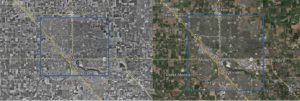
The change in urbanized area from 1998-2015 for Modesto, CA. The city expanded about 0.85% in size annually over the 17 year period from an estimated 47 square miles to 54 square miles.
The population of California is growing and urban development is increasing. According to the latest census, there are about 39.5 million people living within the Golden State. Population is growing around 0.8-0.9% per year, with the anticipation of reaching 40 million Californians by 2018. Migration from other States and Countries, births, and longer life spans are all contributing.
Although a large state in geographical size, this population growth has had a major impact on urbanization. According to the American Farmland Trust organization, there was a 40,000 acre increase in urban development from 2008-2010, with roughly 60% of developed land being considered to be on Prime Farm Ground. Not that much of a surprise considering that the largest cities in California are all on ground that produced high value fruit and vegetable crops (Los Angeles, San Jose, Sacramento, etc). Continue reading

Recent Comments